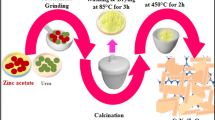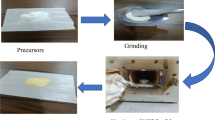Abstract
One of the chief challenges in hydrogen production through the photocatalytic splitting of water is to employ an efficient photocatalyst that has an absorption edge at the range of long wavelengths. In this study, composite structures made of different Ag-based shells over the core of Fe2O3 nanoparticles were utilized as novel magnetic photocatalysts for hydrogen generation from water. Specifically, Ag nanoparticles, Ag/(3-aminopropyl) triethoxysilane (APTS), and Ag/polyethyleneimine (PEI) were capped on the surface of the hematite core to produce three visible light-effective photocatalysts. Structural and textural properties of the synthesized photocatalysts were confirmed by Fourier transform infrared (FTIR), X-ray diffraction (XRD), energy dispersive X-ray spectroscopy (EDS), transmission electron microscopy (TEM), and scanning electron microscopy (SEM). Additionally, their thermal stability and optical properties were respectively studied using thermogravimetric analysis (TGA) and UV reflectance. Photocatalytic activities of the presented core/shells were planned either as a function of the magnetic force or composition of the shell layer. It could be noted that the incorporation of organic or polymer layer could significantly increase the electronic density at the metal centers. Thus, the ability of iron oxide to catalyze the water-splitting process could be enhanced. Hence, the variation of shell structure could show a key-role in the photocatalytic potential of the presented structures in terms of manipulating the composition of produced gases. On the other hand, the magnetic nature of hematite could also positively affect the photocatalytic activity of these structures by minimizing the scattering of light irradiation during the splitting process. Particularly, shifting the way of photocatalysts dispersion from magnetic to mechanical (during water splitting) had in turn reduced hydrogen productivity from 540 to 485 mmol h−1 g−1. This obviously confirms the relationship between the level of hydrogen production by the presented photocatalysts and their magnetic nature which results in quenching of irradiation scattering.










Similar content being viewed by others
References
Abd El-Hafiz DR, El-Temtamy SA, Ebiad MA, El-Salamony RA, Ghoniem SA, El Naggar AMA, Gendy TS (2020) Novel LaNi intercalated Egyptian bentonite clay for direct conversion of methane using CO2 as soft oxidant. Int J Hydrog Energy 45(16):9783–9794. https://doi.org/10.1016/j.ijhydene.2020.02.010
Biabani-Ravandi A, Rezaei M, Fattah Z (2013) Catalytic performance of Ag/Fe2O3 for the low temperature oxidation of carbon monoxide. Chem Eng J 219:124–130. https://doi.org/10.1016/j.cej.2012.12.094
Bokareva OS, Grell G, Bokarev SI, Kühn O (2015) Tuning range-separated density functional theory for photocatalytic water splitting systems. J Chem Theory Comput 11(4):1700–1709 acs.jctc.5b00068
Chen X, Shen S, Guo L, Mao SS (2010) Semiconductor-based photocatalytic hydrogen generation. Chem Rev 110(11):6503–6570. https://doi.org/10.1021/cr1001645
Chen X, Liu L, Peter YY, Mao SS (2011) Increasing solar absorption for photocatalysis with black hydrogenated titanium dioxide nanocrystals. Science 331(6018):746–750. https://doi.org/10.1126/science.1200448
Chen C, Kim J, Ahn W-S (2012a) Efficient carbon dioxide capture over a nitrogen-rich carbon having a hierarchical micro-mesopore structure. Fuel 95:360–364. https://doi.org/10.1016/j.fuel.2011.10.072
Chen X, Li C, Grätzel M, Kostecki R, Mao SS (2012b) Nanomaterials for renewable energy production and storage. Chem Soc Rev 41(23):7909–7937. https://doi.org/10.1039/C2CS35230C
Chen Z, Sun P, Fan B, Zhang Z, Fang X (2014) In situ template-free ion-exchange process to prepare visible-light-active g-C3N4/NiS hybrid photocatalysts with enhanced hydrogen evolution activity. J Phys Chem C 118(15):7801–7807. https://doi.org/10.1021/jp5000232
Chou K-S, Lin M-Y, Wu H-H (2013) Studies on the removal of 2-propanol by Ag@ Fe2O3 core–shell structured catalyst. J Taiwan Inst Chem Eng 44(2):228–232. https://doi.org/10.1016/j.jtice.2012.10.007
Darwish M, Kunz U, Peuker U (2013) Preparation and catalytic use of platinum in magnetic core/shell nanocomposites. J Appl Polym Sci 129(4):1806–1811. https://doi.org/10.1002/app.38864
Darwish MS, Nguyen NH, Ševců A, Stibor I (2015) Functionalized magnetic nanoparticles and their effect on Escherichia coli and Staphylococcus aureus. J Nanomater 2015. https://doi.org/10.1155/2015/416012
Davodi F, Mühlhausen E, Tavakkoli M, Sainio J, Jiang H, Gökce B, Marzun G, Kallio T (2018) Catalyst support effect on the activity and durability of magnetic nanoparticles: toward design of advanced electrocatalyst for full water splitting. ACS Appl Mater Interfaces 10(37):31300–31311. https://doi.org/10.1021/acsami.8b08830
El Naggar AM, Nassar IM, Gobara HM (2013) Enhanced hydrogen production from water via a photo-catalyzed reaction using chalcogenide d-element nanoparticles induced by UV light. Nanoscale 5(20):9994–9999. https://doi.org/10.1039/C3NR02640J
El Naggar AMA, Gobara HM, Nassar IM (2015) Novel nano-structured for the improvement of photo-catalyzed hydrogen production via water splitting with in-situ nano-carbon formation. Renew Sust Energ Rev 41:1205–1216. https://doi.org/10.1016/j.rser.2014.09.001
El Naggar AMA, Awadallah AE, Aboul-Enein AA (2016) Novel intensified nano-structured zero-valente nickel alloy based catalyst for hydrogen production via methane catalytic decomposition. Renew Sust Energ Rev 53:754–765. https://doi.org/10.1016/j.rser.2015.09.014
Fujishima A, Zhang X, Tryk DA (2007) Heterogeneous photocatalysis: from water photolysis to applications in environmental cleanup. Int J Hydrog Energy 32(14):2664–2672. https://doi.org/10.1016/j.ijhydene.2006.09.009
Garcés-Pineda FA, Blasco-Ahicart M, Nieto-Castro D, López N, Galán-Mascarós JR (2019) Direct magnetic enhancement of electrocatalytic water oxidation in alkaline media. Nat Energy 4(6):519–525. https://doi.org/10.1038/s41560-019-0404-4
Garcia D, Picasso G, Hidalgo P, Peres HE, Kou RS, Gonçalves JM (2017) Sensors based on Ag-loaded hematite (α-Fe2O3) nanoparticles for methyl mercaptan detection at room temperature. Anal Chem Res 12:74–81. https://doi.org/10.1016/j.ancr.2016.12.001
Gobara HM, Nassar IM, El Naggar AM, Eshaq G (2017) Nanocrystalline spinel ferrite for an enriched production of hydrogen through a solar energy stimulated water splitting process. Energy 118:1234–1242. https://doi.org/10.1016/j.energy.2016.11.001
Grave DA, Yatom N, Ellis DS, Toroker MC, Rothschild A (2018) The “rust” challenge: on the correlations between electronic structure, excited state dynamics, and photoelectrochemical performance of hematite photoanodes for solar water splitting. Adv Mater 30(41):1706577. https://doi.org/10.1002/adma.201706577
Hamann TW (2012) Splitting water with rust: hematite photoelectrochemistry. Dalton Trans 41(26):7830–7834. https://doi.org/10.1039/C2DT30340J
Han X, Xu D, An L, Hou C, Li Y, Zhang Q, Wang H (2019) Ni-Mo nanoparticles as co-catalyst for drastically enhanced photocatalytic hydrogen production activity over g-C3N4. Appl Catal B Environ 243:136–144. https://doi.org/10.1016/j.apcatb.2018.10.003
Inoue Y (2009) Photocatalytic water splitting by RuO2-loaded metal oxides and nitrides with d 0-and d 10-related electronic configurations. Energy Environ Sci 2(4):364–386. https://doi.org/10.1039/B816677N
Kato H, Kudo A (2001) Water splitting into H2 and O2 on alkali tantalate photocatalysts ATaO3 (A = Li, Na, and K). J Phys Chem B 105(19):4285–4292. https://doi.org/10.1021/jp004386b
Kudo A (2006) Hydrogen production over titania-based photocatalysts. Int J Hydrog Energy 31(2):197–202
Kudo A, Miseki Y (2009) Heterogeneous photocatalyst materials for water splitting. Chem Soc Rev 38(1):253–278. https://doi.org/10.1039/B800489G
Leung DY, Fu X, Wang C, Ni M, Leung MK, Wang X, Fu X (2010) Hydrogen production over titania-based photocatalysts. ChemSusChem 3(6):681–694. https://doi.org/10.1002/cssc.201000014
Li K, Han M, Chen R, Li S-L, Xie S-L, Mao C, Bu X, Cao X-L, Dong L-Z, Feng P, Lan Y-Q (2016) Hexagonal@cubic CdS Core@Shell nanorod photocatalyst for highly active production of H2 with unprecedented stability. Adv Mater 28(40):8906–8911. https://doi.org/10.1002/adma.201601047
Madhumitha A, Preethi V, Kanmani S (2018) Photocatalytic hydrogen production using TiO2 coated iron-oxide core shell particles. Int J Hydrog Energy 43(8):3946–3956. https://doi.org/10.1016/j.ijhydene.2017.12.127
Maeda K, Teramura K, Lu D, Takata T, Saito N, Inoue Y, Domen K (2006) Photocatalyst releasing hydrogen from water. Nature 440(7082):295–295. https://doi.org/10.1038/440295a
Mohamed RS, Al Kahlawy AA, El Naggar AMA, Gobara HM (2020) Innovative approach for the production of carbon nanotubes (CNTs) and carbon nanosheets through highly efficient photocatalytic water splitting into hydrogen using metal organic framework (MOF)-nano TiO2 matrices as novel catalysts. New J Chem 44(13):5097–5108. https://doi.org/10.1039/C9NJ05422G
Moneim MA, El Naggar AMA, El Sayed HA, Mostafa MS, Khalil NM, Hassan MED (2018) Direct conversion of an agricultural solid waste to hydrocarbon gases via the pyrolysis technique. Egypt J Pet 27(4):991–995. https://doi.org/10.1016/j.ejpe.2018.03.008
Nguyen TS, Yavuz CT (2020) Quantifying the nitrogen effect on CO2 capture using isoporous network polymers. Chem Commun 56(31):4273–4275. https://doi.org/10.1039/D0CC00982B
Osterloh FE (2008) Inorganic materials as catalysts for photochemical splitting of water. Chem Mater 20(1):35–54. https://doi.org/10.1021/cm7024203
Osterloh FE (2013) Inorganic nanostructures for photoelectrochemical and photocatalytic water splitting. Chem Soc Rev 42(6):2294–2320. https://doi.org/10.1039/C2CS35266D
Phuan YW, Ong W-J, Chong MN, Ocon JD (2017) Prospects of electrochemically synthesized hematite photoanodes for photoelectrochemical water splitting: a review. J Photochem Photobiol C 33:54–82. https://doi.org/10.1016/j.jphotochemrev.2017.10.001
Preethi V, Kanmani S (2014) Photocatalytic hydrogen production using Fe2O3-based core shell nano particles with ZnS and CdS. Int J Hydrog Energy 39(4):1613–1622. https://doi.org/10.1016/j.ijhydene.2013.11.029
Sivula K, Le Formal F, Grätzel M (2011) Solar water splitting: progress using hematite (α-Fe2O3) photoelectrodes. ChemSusChem 4(4):432–449. https://doi.org/10.1002/cssc.201000416
Tamirat AG, Rick J, Dubale AA, Su W-N, Hwang B-J (2016) Using hematite for photoelectrochemical water splitting: a review of current progress and challenges. Nanoscale Horiz 1(4):243–267. https://doi.org/10.1039/C5NH00098J
Tee SY, Lee CJJ, Dinachali SS, Lai SC, Williams EL, Luo H-K, Chi D, Andy Hor TS, Han M-Y (2015) Amorphous ruthenium nanoparticles for enhanced electrochemical water splitting. Nanotechnology 26(41):415401. https://doi.org/10.1088/0957-4484/26/41/415401
Tian F-Y, Hou D, Tang F, Deng M, X-q Q, Zhang Q, Wu T, Li D-S (2018) Novel Zn0.8Cd0.2S@g-C3N4 core–shell heterojunctions with a twin structure for enhanced visible-light-driven photocatalytic hydrogen generation. J Mater Chem A 6(35):17086–17094. https://doi.org/10.1039/C8TA05927F
Tiwari D, Dunn S (2009) Photochemistry on a polarisable semi-conductor: what do we understand today? J Mater Sci 44(19):5063–5079. https://doi.org/10.1007/s10853-009-3472-1
Wheeler DA, Wang G, Ling Y, Li Y, Zhang JZ (2012) Nanostructured hematite: synthesis, characterization, charge carrier dynamics, and photoelectrochemical properties. Energy Environ Sci 5(5):6682–6702. https://doi.org/10.1039/C2EE00001F
Wu Z-S, Yang S, Sun Y, Parvez K, Feng X, Müllen K (2012) 3D nitrogen-doped graphene aerogel-supported Fe3O4 nanoparticles as efficient electrocatalysts for the oxygen reduction reaction. J Am Chem Soc 134(22):9082–9085. https://doi.org/10.1021/ja3030565
Yang S, Nie C, Liu H, Liu H (2013) Facile synthesis and catalytic application of Ag–Fe2O3–carbons nanocomposites. Mater Lett 100:296–298. https://doi.org/10.1016/j.matlet.2012.12.072
Yang Y, Niu S, Han D, Liu T, Wang G, Li Y (2017) Progress in developing metal oxide nanomaterials for photoelectrochemical water splitting. Adv Energy Mater 7(19):1700555. https://doi.org/10.1002/aenm.201700555
Zhang Z, Yates JT Jr (2012) Band bending in semiconductors: chemical and physical consequences at surfaces and interfaces. Chem Rev 112(10):5520–5551. https://doi.org/10.1021/cr3000626
Zhang J, Wang Y, Jin J, Zhang J, Lin Z, Huang F, Yu J (2013) Efficient visible-light hotocatalytic hydrogen evolution and enhanced photostability of core/Shell CdS/g-C3N4 nanowires. ACS Appl Mater Interfaces 5(20):10317–10324. https://doi.org/10.1021/am403327g
Zou Z, Ye J, Sayama K, Arakawa H (2010) Direct splitting of water under visible light irradiation with an oxide semiconductor photocatalyst, Materials For Sustainable Energy: A Collection of Peer-Reviewed Research and Review Articles from Nature Publishing Group. In: World Scientific, pp 293–295
Author information
Authors and Affiliations
Corresponding author
Ethics declarations
Conflict of interest
The authors declare that they have no conflict of interest.
Additional information
Responsible Editor: Sami Rtimi
Publisher’s note
Springer Nature remains neutral with regard to jurisdictional claims in published maps and institutional affiliations.
Rights and permissions
About this article
Cite this article
Darwish, M.S., El Naggar, A.M., Morshedy, A.S. et al. Increased production of hydrogen with in situ CO2 capture through the process of water splitting using magnetic core/shell structures as novel photocatalysts. Environ Sci Pollut Res 28, 3566–3578 (2021). https://doi.org/10.1007/s11356-020-10752-w
Received:
Accepted:
Published:
Issue Date:
DOI: https://doi.org/10.1007/s11356-020-10752-w




